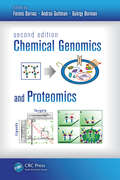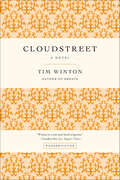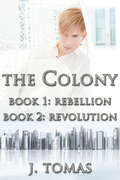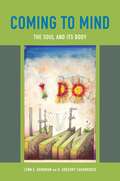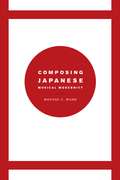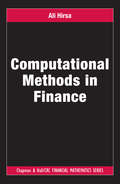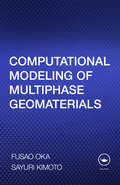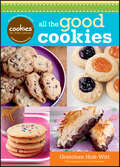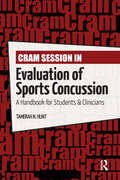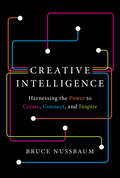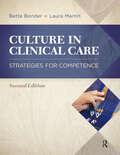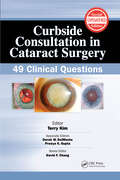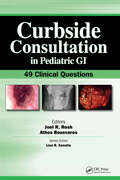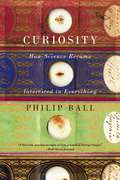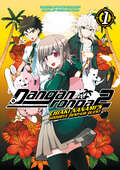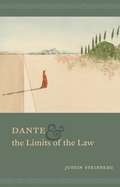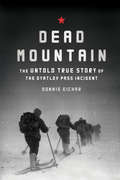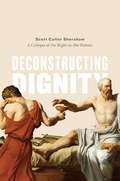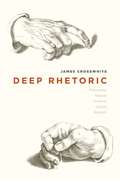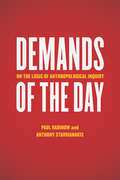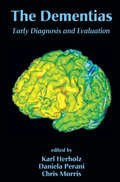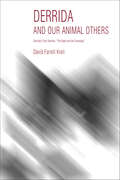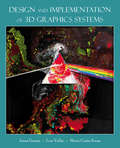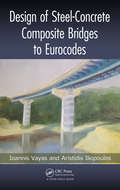- Table View
- List View
Chemical Genomics and Proteomics
by András Guttman Ferenc Darvas György DormánSince the publication of the pioneering first edition of Chemical Genomics and Proteomics more than seven years ago, the area of chemical genomics has rapidly expanded and diversified to numerous novel methods and subdisciplines, such as chemical glycomics and lipidomics. This second edition has been updated to uniquely reflect this interdisciplinary feature as well as the remarkable developments that have occurred. The new edition also covers innovative applications from cell biology to drug discovery to, more recently, clinical diagnostics and medical practice.
Chickens in the Road: An Adventure in Ordinary Splendor
by Suzanne McMinnSuzanne McMinn, a former romance writer and founder of the popular blog chickensintheroad.com, shares the story of her search to lead a life of ordinary splendor in Chickens in the Road, her inspiring and funny memoir.Craving a life that would connect her to the earth and her family roots, McMinn packed up her three kids, left her husband and her sterile suburban existence behind, and moved to rural West Virginia. Amid the rough landscape and beauty of this rural mountain country, she pursues a natural lifestyle filled with chickens, goats, sheep—and no pizza delivery.With her new life comes an unexpected new love—"52," a man as beguiling and enigmatic as his nickname—a turbulent romance that reminds her that peace and fulfillment can be found in the wake of heartbreak. Coping with formidable challenges, including raising a trio of teenagers, milking stubborn cows, being snowed in with no heat, and making her own butter, McMinn realizes that she’s living a forty-something’s coming-of-age story.As she dares to become self-reliant and embrace her independence, she reminds us that life is a bold adventure—if we’re willing to live it. Chickens in the Road includes more than 20 recipes, craft projects, and McMinn’s photography, and features a special two-color design.
Cloudstreet: A Novel
by Tim WintonFrom award-winning author Tim Winton comes an epic novel that regularly tops the list of best-loved novels in Australia.After two separate catastrophes, two very different families leave the country for the bright lights of Perth. The Lambs are industrious, united, and—until God seems to turn His back on their boy Fish—religious. The Pickleses are gamblers, boozers, fractious, and unlikely landlords.Change, hardship, and the war force them to swallow their dignity and share a great, breathing, shuddering house called Cloudstreet. Over the next twenty years, they struggle and strive, laugh and curse, come apart and pull together under the same roof, and try as they can to make their lives.Winner of the Miles Franklin Award and recognized as one of the greatest works of Australian literature, Cloudstreet is Tim Winton's sprawling, comic epic about luck and love, fortitude and forgiveness, and the magic of the everyday.
The Colony Box Set (The Colony #3)
by J. TomasThis collection combines both books in J. Tomas's successful gay dystopian YA romance,The Colony:Rebellion: In the Colony, Aine’s life was decided at birth. The girl next door is his Other, whom he will marry one day. As long as he continues to take his pills, life will be good and he will be safe. But when he accidentally drops one, he learns he has feelings for Kyer, his best friend. Another boy.Revolution: Aine and Kyer escaped the Colony, but it doesn’t take long for them to tire of living outside its walls. Aine decides to return and, as the next Overseer, bring about some much-needed changes. But breaking back in proves even harder than breaking out. They must dodge Officers, evade Monitors, and convince the people they deserves better. Will anyone listen?
Coming to Mind: The Soul and Its Body
by Lenn E. Goodman D. Gregory CaramencioHow should we speak of bodies and souls? In Coming to Mind, Lenn E. Goodman and D. Gregory Caramenico pick their way through the minefields of materialist reductionism to present the soul not as the brain’s rival but as its partner. What acts, they argue, is what is real. The soul is not an ethereal wisp but a lively subject, emergent from the body but inadequately described in its terms. Rooted in some of the richest philosophical and intellectual traditions of Western and Eastern philosophy, psychology, literature, and the arts and the latest findings of cognitive psychology and brain science—Coming to Mind is a subtle manifesto of a new humanism and an outstanding contribution to our understanding of the human person. Drawing on new and classical understandings of perception, consciousness, memory, agency, and creativity, Goodman and Caramenico frame a convincing argument for a dynamic and integrated self capable of language, thought, discovery, caring, and love.
Composing Japanese Musical Modernity (Chicago Studies In Ethnomusicology Ser.)
by Bonnie C. WadeWhen we think of composers, we usually envision an isolated artist separate from the orchestra—someone alone in a study, surround by staff paper—and in Europe and America this image generally has been accurate. For most of Japan’s musical history, however, no such role existed—composition and performance were deeply intertwined. Only when Japan began to embrace Western culture in the late nineteenth century did the role of the composer emerge. In Composing Japanese Musical Modernity, Bonnie Wade uses an investigation of this new musical role to offer new insights not just into Japanese music but Japanese modernity at large and global cosmopolitan culture. Wade examines the short history of the composer in Japanese society, looking at the creative and economic opportunities that have sprung up around them—or that they forged—during Japan’s astonishingly fast modernization. She shows that modernist Japanese composers have not bought into the high modernist concept of the autonomous artist, instead remaining connected to the people. Articulating Japanese modernism in this way, Wade tells a larger story of international musical life, of the spaces in which tradition and modernity are able to meet and, ultimately, where modernity itself has been made.
Computational Methods in Finance (Chapman and Hall/CRC Financial Mathematics Series)
by Ali HirsaHelping readers accurately price a vast array of derivatives, this self-contained text explains how to solve complex functional equations through numerical methods. It addresses key computational methods in finance, including transform techniques, the finite difference method, and Monte Carlo simulation. Developed from his courses at Columbia University and the Courant Institute of New York University, the author also covers model calibration and optimization and describes techniques, such as Kalman and particle filters, for parameter estimation.
Computational Modeling of Multiphase Geomaterials
by Fusao Oka Sayuri KimotoComputational Modeling of Multiphase Geomaterials discusses how numerical methods play a very important role in geotechnical engineering and in the related activity of computational geotechnics. It shows how numerical methods and constitutive modeling can help predict the behavior of geomaterials such as soil and rock.After presenting the fundament
Cookies For Kids' Cancer: All The Good Cookies
by Gretchen Holt-WittA new collection of delicious cookie recipes—all for a good causeIn 2007, Gretchen Holt-Witt set the lofty goal of baking and selling 96,000 cookies during the holidays, all in the name of funding research for pediatric cancer, the #1 killer of kids in the United States and the disease her young son was battling. Armed with the determination of a mom on a mission plus the knowledge that funds for research mean more treatment options, better survival rates, and hope for the future, Holt-Witt succeeded in selling all 96,000 cookies and raising over $400,000 for new pediatric cancer treatments. Soon after, Gretchen and her husband Larry founded Cookies for Kids' Cancer (cookiesforkidscancer.org), a national nonprofit that inspires people to host bake sales of all sizes, from desktops and porches to entire corporations and communities, with some raising more than $100,000 in a day. Gretchen's first book, Cookies for Kids' Cancer Best Bake Sale Cookbook, raised thousands more for pediatric cancer research. All the Good Cookies gathers a mouthwatering collection of recipes that promise to satisfy any cookie craving, with the author's profits again going to the charity. Features a wealth of cookie recipes, from Raspberry Thumbprints to Boston Cream Whoopie PiesAll of the author's royalties will benefit the charity Cookies for Kids' CancerA follow-up to the successful Cookies for Kids' Cancer Best Bake Sale CookbookFor anyone who loves baking cookies and making a real difference in the world, Cookies for Kids' Cancer: All the Good Cookies is a perfect way to do both at the same time.
Cram Session in Evaluation of Sports Concussion: A Handbook for Students & Clinicians
by Tamerah HuntWhen you need a fundamental and clinical understanding of sports concussions, supplemented by current research and management techniques, look to Cram Session in Evaluation of Sports Concussion: A Handbook for Students & Clinicians for quick and at-your-fingertips facts.Cram Session in Evaluation of Sports Concussion: A Handbook for Students & Clinicians by Dr. Tamerah N. Hunt is a succinct and descriptive quick reference that provides the health care professional with a simple step-by-step approach to various sports concussion assessment and management techniques. Cram Session in Evaluation of Sports Concussion: A Handbook for Students & Clinicians is designed to bridge the gap between research and clinical practice to improve assessment and management of sports-related concussion and return-to-play decisions. What is in your “Cram Session”: • Concept maps• Red flags for differential diagnoses• Return to participation guidelines• Detailed algorithms for evaluation, testing, and working with other health care professionals• Model protocols and management strategies that can be implemented with minimal resources and support staffCram Session in Evaluation of Sports Concussion: A Handbook for Students & Clinicians is an informative, well-organized handbook for all students and clinicians in athletic training, physical therapy, and allied health professionals who evaluate and manage concussions.
Creative Intelligence: Harnessing the Power to Create, Connect, and Inspire
by Bruce NussbaumOffering insights from the spheres of anthropology, psychology, education, design, and business, Creative Intelligence by Bruce Nussbaum, a leading thinker, commentator, and curator on the subjects of design, creativity, and innovation, is first book to identify and explore creative intelligence as a new form of cultural literacy and as a powerful method for problem-solving, driving innovation, and sparking start-up capitalism.Nussbaum investigates the ways in which individuals, corporations, and nations are boosting their creative intelligence — CQ—and how that translates into their abilities to make new products and solve new problems. Ultimately, Creative Intelligence shows how to frame problems in new ways and devise solutions that are original and highly social. Smart and eye opening, Creative Intelligence: Harnessing the Power to Create, Connect, and Inspire illustrates how to connect our creative output with a new type of economic system, Indie Capitalism, where creativity is the source of value, where entrepreneurs drive growth, and where social networks are the building blocks of the economy.
Culture in Clinical Care: Strategies for Competence
by Laura Martin Bette BonderCulture in Clinical Care: Strategies for Competence explores theory and practice to define and describe the multidimensional nature of culture and its interaction with an individual’s experience in the development of beliefs, values, and behavior. The newly updated Second Edition examines cultural beliefs related to health and wellness and how these beliefs and their associated actions affect intervention strategies.Based on ethnographic methods, strategies for culturally sensitive assessment and intervention are defined and illustrated, with ample opportunities for reflection and practice. Going beyond traditional fact-centered and attitude-centered approaches, Culture in Clinical Care, Second Edition describes the ways in which culture emerges as individuals interact with each other in physical and social environments. This one-of-a-kind text by Dr. Bette Bonder and Dr. Laura Martin provides health care practitioners and students with chapter objectives, critical thinking questions, interdisciplinary case studies and examples, numerous activities to build observation and interaction skills, comprehensive references and online resources, and images. The book’s organization emphasizes practice and reflection by interweaving theory, examples, and continuous hands-on application of concepts. Readers have the opportunity to practice what they are learning and evaluate their own effectiveness while being constantly reminded that all individuals in any interaction embody numerous cultural influences.Benefits of the updated Second Edition:• Training and practice in ethnographic methods that build awareness and skill• Numerous examples, exercises, and activities for reflection and observation• Interdisciplinary approach suitable for cross-disciplinary teaching contexts• Definition of health care professions themselves as cultures• Web and bibliographic resources• Case studies involving a wide range of practitioner disciplines and cultural groupsCulture in Clinical Care: Strategies for Competence, Second Edition fills a niche in health professions programs because of its combined emphasis on a theoretical foundation that highlights the individual as a cultural actor and on practical strategies and methods for clinical interventions.Instructors in educational settings can visit www.efacultylounge.com for additional material to be used in the classroom, including a sample syllabus.Occupational therapists, physicians, physician assistants, mental health professionals, and a variety of related health professionals will benefit from this interactive, interdisciplinary text.
Curbside Consultation in Cataract Surgery: 49 Clinical Questions (Curbside Consultation in Ophthalmology)
by Terry KimCurbside Consultation in Cataract Surgery: 49 Clinical Questions has been updated into a Second Edition!The Second Edition contains new questions and is completely updated! Curbside Consultation in Cataract Surgery, Second Edition contains new questions and brief, practical, and evidence-based answers to the most frequently asked questions that are posed during a “curbside consultation” between surgical colleagues. Dr. Terry Kim and associate editors Drs. Derek Delmonte and Preeya Gupta have assembled 49 of the top cataract consultants from the U.S. and abroad to offer expert advice, preferences, and opinions on tough clinical questions commonly associated with cataract surgery in this updated reference. The unique Q&A format provides quick access to current information related to cataract surgery in the simplicity of a conversation between two colleagues. Numerous images, diagrams, and references are included to enhance the text and to illustrate surgical pearls. Some of the questions that are answered inside the Second Edition include:• My patient has unreliable topography due to ocular surface pathology. What are my options for treatment and IOL selection?• How do I pick the right IOL formula for my patient with a longer/shorter than average eye?• My capsulorhexis is heading out peripherally. How should I proceed and what should I do if it tears radially?• How/when should I change my phaco/fluidics settings in the following situations: IFIS, shallow chamber, high axial length, post vitrectomy?• I have a radial tear in the anterior capsule. How do I proceed with phaco and IOL implantation?• When should I use a toric intraocular lens versus astigmatic keratotomy/LRI?• How do I incorporate femtosecond (FS) laser into my current cataract surgery techniques?Curbside Consultation in Cataract Surgery: 49 Clinical Questions, Second Edition provides information basic enough for residents while also incorporating expert pearls that even experienced cataract surgeons will appreciate. General ophthalmologists, residents, and cataract specialists alike will benefit from the user-friendly and casual format as well as the expert advice contained within.
Curbside Consultation in Pediatric GI: 49 Clinical Questions (Curbside Consultation in Pediatrics)
by Athos Bousvaros Joel RoshAre you looking for concise, practical answers to those questions that are often left unanswered by traditional pediatric GI references? Are you seeking brief, evidence-based advice for complicated cases or controversial decisions? Curbside Consultation in Pediatric GI: 49 Clinical Questions provides quick answers to the tricky questions most commonly posed during a “curbside consultation” between pediatricians. Drs. Joel R. Rosh and Athos Bousvaros have designed this unique reference which offers expert advice, preferences, and opinions on tough clinical questions commonly associated with pediatric GI. The unique Q&A format provides quick access to current information related to pediatric GI with the simplicity of a conversation between two colleagues. Numerous images, diagrams, and references allow readers to browse large amounts of information in an expedited fashion. Some of the questions that are answered: • How is infantile colic diagnosed and treated?• How is GERD diagnosed in infants and what are the best treatments?• How can I optimize my treatment of childhood constipation and does this vary by age?• How can I effectively intervene in a child that is overweight or obese?• Celiac disease seems so much more common—is this an epidemic?• Why have food allergies become so common and what are the most accurate means of diagnosis? Curbside Consultation in Pediatric GI: 49 Clinical Questions provides information basic enough for residents while also incorporating expert advice that even high-volume pediatricians will appreciate. Pediatricians, nurse practitioners, physician assistants, family practitioners and pediatric residents will benefit from the user-friendly, casual format and the expert advice contained within.
Curiosity: How Science Became Interested in Everything
by Philip BallWith the recent landing of the Mars rover Curiosity, it seems safe to assume that the idea of being curious is alive and well in modern science—that it’s not merely encouraged but is seen as an essential component of the scientific mission. Yet there was a time when curiosity was condemned. Neither Pandora nor Eve could resist the dangerous allure of unanswered questions, and all knowledge wasn’t equal—for millennia it was believed that there were some things we should not try to know. In the late sixteenth century this attitude began to change dramatically, and in Curiosity:How Science Became Interested in Everything, Philip Ball investigates how curiosity first became sanctioned—when it changed from a vice to a virtue and how it became permissible to ask any and every question about the world. Looking closely at the sixteenth through eighteenth centuries, Ball vividly brings to life the age when modern science began, a time that spans the lives of Galileo and Isaac Newton. In this entertaining and illuminating account of the rise of science as we know it, Ball tells of scientists both legendary and lesser known, from Copernicus and Kepler to Robert Boyle, as well as the inventions and technologies that were inspired by curiosity itself, such as the telescope and the microscope. The so-called Scientific Revolution is often told as a story of great geniuses illuminating the world with flashes of inspiration. But Curiosity reveals a more complex story, in which the liberation—and subsequent taming—of curiosity was linked to magic, religion, literature, travel, trade, and empire. Ball also asks what has become of curiosity today: how it functions in science, how it is spun and packaged for consumption, how well it is being sustained, and how the changing shape of science influences the kinds of questions it may continue to ask. Though proverbial wisdom tell us that it was through curiosity that our innocence was lost, that has not deterred us. Instead, it has been completely the contrary: today we spend vast sums trying to reconstruct the first instants of creation in particle accelerators, out of a pure desire to know. Ball refuses to let us take this desire for granted, and this book is a perfect homage to such an inquisitive attitude.
Danganronpa 2: Chiaki Nanami's Goodbye Despair Quest Volume 1 (Danganronpa 2)
by Karin Suzuragi&“I guess you could say gaming is my life…or my life is a game.&”What could be nicer than the semester at the elite Hope&’s Peak High School to kick off with a class trip to the tropical resort of Jabberwock Island? And what could be more horrific to then be told by the principal that now they&’re all trapped there…and the only way they can ever leave is to play a murder game!The rules are simple: to escape, you must not only kill a fellow student, but get away with it, as the survivors will then cross-examine each other in a class courtroom. If they vote the wrong person guilty, the killer goes free…and the rest of them die!Chiaki Nanami is the Ultimate Gamer, selected as one of Japan&’s most expert teens to attend Hope&’s Peak High School. With no margin for error and the stakes so high, the Ultimate Gamer will need to use all her playing skill to suss out the secrets of Jabberwock Island and find the &“true ending&” for Nanami and her friends…survival and escape!
Dante & the Limits of the Law
by Justin SteinbergIn Dante and the Limits of the Law, Justin Steinberg offers the first comprehensive study of the legal structure essential to Dante’s Divine Comedy. Steinberg reveals how Dante imagines an afterlife dominated by sophisticated laws, hierarchical jurisdictions, and rationalized punishments and rewards. He makes the compelling case that Dante deliberately exploits this highly structured legal system to explore the phenomenon of exceptions to it, crucially introducing Dante to current debates about literature’s relation to law, exceptionality, and sovereignty. Examining how Dante probes the limits of the law in this juridical otherworld, Steinberg argues that exceptions were vital to the medieval legal order and that Dante’s otherworld represents an ideal “system of exception.” In the real world, Dante saw this system as increasingly threatened by the dual crises of church and empire: the abuses and overreaching of the popes and the absence of an effective Holy Roman Emperor. Steinberg shows that Dante’s imagination of the afterlife seeks to address this gap between the universal validity of Roman law and the lack of a sovereign power to enforce it. Exploring the institutional role of disgrace, the entwined phenomena of judicial discretion and artistic freedom, medieval ideas about privilege and immunity, and the place of judgment in the poem, this cogently argued book brings to life Dante’s sense of justice.
Dead Mountain: The Untold True Story of the Dyatlov Pass Incident
by Donnie EicharThe New York Times and Wall Street Journal Nonfiction Bestseller that explores the gripping Dyatlov Pass incident that took the lives of nine young Russian hikers in 1959.What happened that night on Dead Mountain?In February 1959, a group of nine experienced hikers in the Russian Ural Mountains died mysteriously on an elevation known as Dead Mountain. Eerie aspects of the mountain climbing incident—unexplained violent injuries, signs that they cut open and fled the tent without proper clothing or shoes, a strange final photograph taken by one of the hikers, and elevated levels of radiation found on some of their clothes—have led to decades of speculation over the true stories and what really happened.Dead Mountain: The Untold True Story of the Dyatlov Pass Incident delves into the untold story through unprecedented access to the hikers' own journals and photographs, rarely seen government records, dozens of interviews, and author Donnie Eichar's retracing of the hikers' fateful journey in the Russian winter.An instant historical nonfiction bestseller upon its release, this is the dramatic real story of what happened on Dead Mountain.GRIPPING AND BIZARRE: This is a fascinating portrait of young adventurers in the Soviet era, and a skillful interweaving of the hikers' narrative, the investigators' efforts, and the author's investigations. Library Journal hailed "the drama and poignancy of Eichar's solid depiction of this truly eerie and enduring mystery."FOR FANS OF UNSOLVED MYSTERIES: Unsolved true crimes and historical mysteries never cease to capture our imaginations. The Dyatlov Pass incident was little known outside of Russia until film producer and director Donnie Eichar brought the decades-old mystery to light in a book that reads like a mystery.FASCINATING VISUALS: This well-researched volume includes black-and-white photographs from the cameras that belonged to the hikers, which were recovered after their deaths, along with explanatory graphics breaking down some of the theories surrounding the mysterious incident.Perfect for:Fans of nonfiction history books and true crimeAnyone who enjoys real-life mountaineering and survival stories such as Into Thin Air, Buried in the Sky, The Moth and the Mountain, and Icebound: Shipwrecked at the Edge of the WorldReaders seeking Cold War narratives and true stories from the Soviet era
Deconstructing Dignity: A Critique of the Right-to-Die Debate
by Scott Cutler ShershowThe right-to-die debate has gone on for centuries, playing out most recently as a spectacle of protest surrounding figures such as Terry Schiavo. In Deconstructing Dignity, Scott Cutler Shershow offers a powerful new way of thinking about it philosophically. Focusing on the concepts of human dignity and the sanctity of life, he employs Derridean deconstruction to uncover self-contradictory and damaging assumptions that underlie both sides of the debate. Shershow examines texts from Cicero’s De Officiis to Kant’s Groundwork of the Metaphysics of Morals to court decisions and religious declarations. Through them he reveals how arguments both supporting and denying the right to die undermine their own unconditional concepts of human dignity and the sanctity of life with a hidden conditional logic, one often tied to practical economic concerns and the scarcity or unequal distribution of medical resources. He goes on to examine the exceptional case of self-sacrifice, closing with a vision of a society—one whose conditions we are far from meeting—in which the debate can finally be resolved. A sophisticated analysis of a heated topic, Deconstructing Dignity is also a masterful example of deconstructionist methods at work.
Deep Rhetoric: Philosophy, Reason, Violence, Justice, Wisdom
by James Crosswhite“Rhetoric is the counterpart of logic,” claimed Aristotle. “Rhetoric is the first part of logic rightly understood,” Martin Heidegger concurred. “Rhetoric is the universal form of human communication,” opined Hans-Georg Gadamer. But in Deep Rhetoric, James Crosswhite offers a groundbreaking new conception of rhetoric, one that builds a definitive case for an understanding of the discipline as a philosophical enterprise beyond basic argumentation and is fully conversant with the advances of the New Rhetoric of Chaïm Perelman and Lucie Olbrechts-Tyteca. Chapter by chapter, Deep Rhetoric develops an understanding of rhetoric not only in its philosophical dimension but also as a means of guiding and conducting conflicts, achieving justice, and understanding the human condition. Along the way, Crosswhite restores the traditional dignity and importance of the discipline and illuminates the twentieth-century resurgence of rhetoric among philosophers, as well as the role that rhetoric can play in future discussions of ontology, epistemology, and ethics. At a time when the fields of philosophy and rhetoric have diverged, Crosswhite returns them to their common moorings and shows us an invigorating new way forward.
Demands of the Day: On the Logic of Anthropological Inquiry
by Paul Rabinow Anthony StavrianakisDemands of the Day asks about the logical standards and forms that should guide ethical and experimental anthropology in the twenty-first century. Anthropologists Paul Rabinow and Anthony Stavrianakis do so by taking up Max Weber’s notion of the “demands of the day.” Just as the demand of the day for anthropology decades ago consisted of thinking about fieldwork, today, they argue, the demand is to examine what happens after, how the experiences of fieldwork are gathered, curated, narrated, and ultimately made available for an anthropological practice that moves beyond mere ethnographic description. Rabinow and Stavrianakis draw on experiences from an innovative set of anthropological experiments that investigated how and whether the human and biological sciences could be brought into a mutually enriching relationship. Conceptualizing the anthropological and philosophic ramifications of these inquiries, they offer a bold challenge to contemporary anthropology to undertake a more rigorous examination of its own practices, blind spots, and capacities, in order to meet the demands of our day.
The Dementias: Early Diagnosis and Evaluation
by Chris Morris Karl Herholz Daniela PeraniThe only guide to focus primarily on current molecular methods of diagnosis and early stage evaluation, this reference presents the latest techniques and technologies for dementia identification and evaluation, including neuropathological strategies, neuropsychological tests, biomarkers, CT, MRI, functional MRI, PET, and SPECT. Offering practical care and examination guidelines, each chapter provides findings that are particularly relevant for the assessment of disorders such as Alzheimer's disease, dementia with Lewy bodies, vascular dementia, and fronto-temporal dementia.
Derrida and Our Animal Others: Derrida's Final Seminar, "The Beast and the Sovereign" (Studies in Continental Thought)
by David Farrell KrellJacques Derrida's final seminars were devoted to animal life and political sovereignty—the connection being that animals slavishly adhere to the law while kings and gods tower above it and that this relationship reveals much about humanity in the West. David Farrell Krell offers a detailed account of these seminars, placing them in the context of Derrida's late work and his critique of Heidegger. Krell focuses his discussion on questions such as death, language, and animality. He concludes that Heidegger and Derrida share a commitment to finding new ways of speaking and thinking about human and animal life.
Design and Implementation of 3D Graphics Systems
by Luiz Velho Jonas de Gomes Mario Costa SousaThis book covers the computational aspects of geometric modeling and rendering 3D scenes. Special emphasis is given to the architectural aspects of interactive graphics, geometric modeling, rendering techniques, the graphics pipeline, and the architecture of 3D graphics systems. The text describes basic 3D computer graphics algorithms and their implementation in the C language. The material is complemented by library routines for constructing graphics systems, which are available for download from the book's website.
Design of Steel-Concrete Composite Bridges to Eurocodes
by Ioannis Vayas Aristidis IliopoulosCombining a theoretical background with engineering practice, Design of Steel-Concrete Composite Bridges to Eurocodes covers the conceptual and detailed design of composite bridges in accordance with the Eurocodes. Bridge design is strongly based on prescriptive normative rules regarding loads and their combinations, safety factors, material proper
